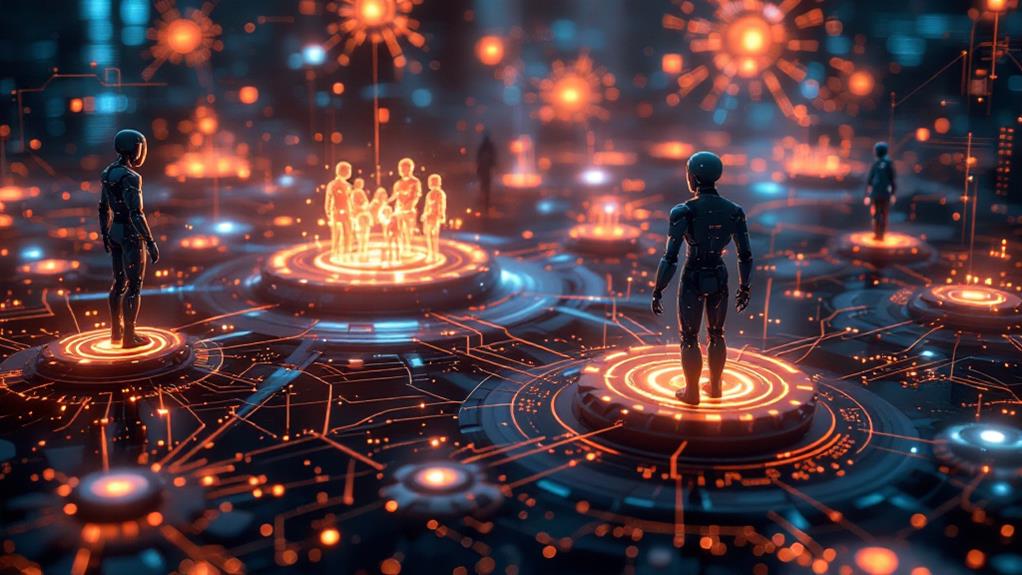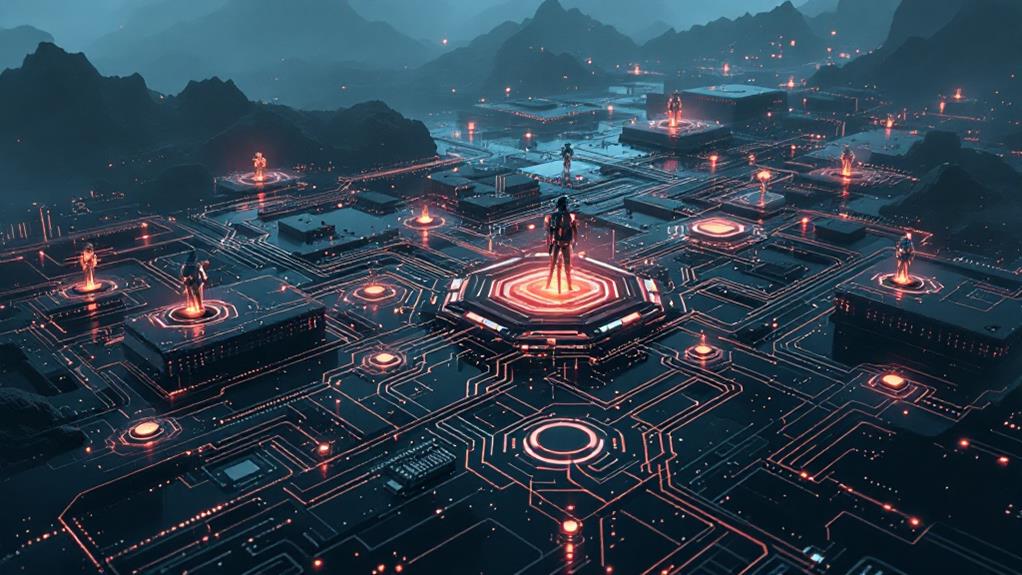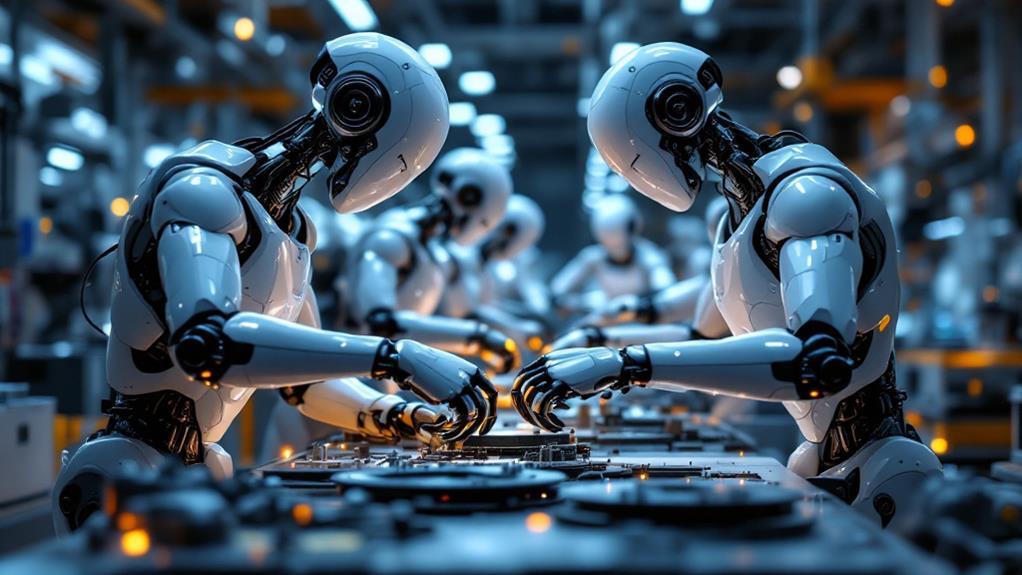What Are AI-Driven Bots? Exploring the World of Automated Intelligence

AI-driven bots are intelligent software programs designed to improve your digital interactions. They're powered by technologies like machine learning and natural language processing, enabling them to communicate like humans, automate tasks, and provide personalized recommendations. You'll find these bots everywhere, from chatbots that handle customer inquiries to virtual assistants that manage your daily schedule. Key features include task automation, natural language understanding, and even emotional intelligence. They increase efficiency and engagement across different industries, from healthcare to marketing. While they offer many benefits, challenges like data privacy and technological bias persist. There's much more to learn about these digital companions.
Understanding AI-Driven Bots
In the world of technology, grasping the concept of AI-driven bots is vital for anyone looking to understand modern digital interactions. When you engage with an AI-driven bot, you're experiencing a carefully designed interaction that aims to improve your user experience. These bots are more than just lines of code; they're sophisticated systems developed to perform tasks, answer queries, and even provide recommendations. By understanding how they function, you can appreciate the seamlessness they bring to many online interactions.
AI-driven bots have transformed how you interact with digital platforms. Regardless of whether you're chatting with a customer service bot or receiving personalized suggestions from a shopping assistant, these bots are fine-tuned to meet your needs. Their ability to understand natural language, process information, and deliver accurate responses is what makes your user experience smoother and more intuitive. This interaction mimics human-like communication, making it easier for you to get the information or service you need without hassle.
As you investigate different platforms, notice how bot interaction is integrated into your daily digital routine. Understanding these bots equips you with the knowledge to navigate and utilize their capabilities efficiently, improving your digital experience.
How AI Algorithms Work
Delving into the mechanics of AI algorithms reveals how these powerful tools drive AI-driven bots. At the core, machine learning forms the backbone, allowing bots to learn from vast amounts of data. You tap into neural networks, which mirror how the human brain processes information, enabling complex data processing. These networks adjust themselves through algorithm optimization, improving accuracy and efficiency over time.
Predictive modeling is another essential component, helping bots anticipate outcomes based on historical data. This is where decision trees come into play, providing a structured way for bots to make decisions by evaluating diverse possibilities. With reinforcement learning, bots continuously improve their performance by receiving feedback from their actions, akin to a trial-and-error approach.
Handling natural language is vital for bots interacting with humans. Natural language processing (NLP) enables these bots to understand, interpret, and generate human language, bridging the gap between machine logic and human communication. By integrating these elements, AI algorithms empower bots not just to perform tasks, but to do so intelligently and adaptively, constantly refining their abilities and providing increasingly sophisticated solutions to intricate problems.
Key Features of Intelligent Bots

Understanding how AI algorithms function lays the groundwork for recognizing the key features that make intelligent bots stand out. These bots excel in understanding and processing natural language, allowing you to interact with them in a way that feels more like a human conversation. This improves user engagement by making interactions smoother and more intuitive.
Task automation is another crucial feature. Intelligent bots can handle repetitive tasks efficiently, freeing up your time for more vital activities. They use advanced machine learning techniques to continually improve their performance over time, adapting to your needs and preferences.
Personalization strategies are at the core of intelligent bots. They analyze data to tailor their responses and actions specifically to you, making each interaction feel unique and relevant. By employing data analysis, these bots can predict what you might need next, enhancing the complete experience.
Emotional intelligence is a growing feature in intelligent bots. They can recognize and appropriately respond to your emotions, adding a layer of empathy to interactions. Conversational interfaces make these exchanges even more seamless, providing a user-friendly way to communicate with technology. By combining these features, intelligent bots offer a sophisticated, efficient, and personalized experience.
Popular Types of AI Bots
AI bots have become integral across numerous sectors, each tailored for specific tasks and industries. Among the most popular types are chatbots and virtual assistants. Chatbots, a result of the chatbots evolution, have transformed how businesses interact with customers. They can handle a wide range of inquiries, from simple FAQs to more complex customer service issues, all without human intervention. You've likely encountered them on websites, where they pop up to offer instant assistance, streamlining communication and saving time.
Virtual assistants, on the other hand, have made their mark in personal and professional settings. You might know them as Siri, Alexa, or Google Assistant. These bots do more than just answer questions; they manage schedules, control smart home devices, and even make reminders. They're crafted to understand natural language, making interactions feel more human-like and intuitive.
Another popular type is the predictive bot, which uses data analysis to forecast trends and suggest actions. These bots are invaluable in sectors like finance and marketing, where anticipating customer behavior can lead to better decision-making. By leveraging AI, these bots improve productivity and efficiency across different domains.
Industry Applications

Across diverse industries, AI-driven bots are making significant impacts by enhancing efficiency and streamlining operations. In customer service, AI bots handle inquiries around the clock, reducing wait times and improving user satisfaction. They're capable of learning from interactions, allowing them to provide better responses over time. Meanwhile, in data analysis, these bots sift through vast amounts of information quickly, identifying trends and insights that would take humans much longer to uncover.
Marketing automation has also seen a revolution with AI bots. They personalize recommendations and tailor marketing strategies to individual consumer behavior, increasing engagement and conversion rates. In the domain of healthcare, virtual assistants remind patients of appointments, provide medication guidelines, and even monitor health metrics, ensuring timely interventions and freeing up professionals for more complex tasks.
Financial forecasting is another area where AI bots shine. They analyze market data to predict trends, helping companies make informed investment decisions. In the supply chain, bots optimize logistics by predicting demands and managing inventory, ensuring smooth operations from production to delivery. By integrating AI bots into these areas, you're not just keeping up with technological advancements; you're setting the stage for a more efficient and responsive business environment.
Benefits of Using AI Bots
Harnessing the power of AI bots offers numerous benefits that can transform your business operations. Initially, they drive cost efficiency by automating repetitive tasks, allowing you to allocate resources more effectively. With AI bots, you're not just cutting costs; you're also improving user engagement. These bots can interact with users 24/7, providing real-time responses that keep your audience engaged and satisfied.
In customer support, AI bots provide consistent and accurate assistance, reducing human error and freeing up your team to handle more complex issues. They excel in data analysis, sifting through massive amounts of data quickly, providing insights that aid in decision making. This capability saves you time and guarantees you're making informed decisions based on solid data.
AI bots also offer a high degree of personalization, tailoring interactions to individual users, which can elevate customer satisfaction and loyalty. Their scalability is another advantage; as your business grows, AI bots can handle increased demand without the need for additional manpower. In summary, integrating AI bots into your operations not only streamlines processes but also improves your ability to provide personalized, efficient service across the board.
Challenges and Limitations

Despite the numerous benefits, embracing AI bots in your business isn't without its challenges and limitations. One significant concern is data privacy. As AI bots handle sensitive information, ensuring robust security measures is essential to protect against breaches. Ethical concerns also arise, especially regarding how data is collected and used. You must be vigilant about compliance with regulations and maintaining user trust.
Technological bias is another hurdle. AI systems can inadvertently perpetuate biases present in training data, which could lead to unfair outcomes. Addressing these biases requires ongoing attention and refinement. Furthermore, user dependency on AI bots might lead to reduced human involvement, potentially impacting vital thinking and problem-solving skills within your team.
Maintenance costs can accumulate quickly. Keeping AI systems updated and optimized demands resources, and any integration challenges with existing systems can complicate deployment. Scalability issues may also emerge as your business grows, making it difficult for AI bots to maintain consistent performance.
Future of Automated Intelligence
The future of automated intelligence promises transformative changes to businesses and society. As you look ahead, technological advancements will certainly improve efficiency and innovation. However, with these advancements come ethical considerations that must be addressed. Future predictions suggest that AI-driven bots could lead to job displacement, raising concerns about the societal impacts. It's vital to take into account how these changes will affect employment and economic structures.
Regulatory frameworks will need to evolve to guarantee that the integration of AI respects privacy and security while promoting fair human bot interaction. As these frameworks develop, they'll play a significant role in shaping how AI is used and accepted by users. You might wonder how people will react to these changes. User acceptance will depend on how well AI systems are designed to improve, rather than hinder, human experiences.
In the face of these challenges, it's important to focus on creating AI systems that complement human abilities. By fostering positive human bot interactions, we can guarantee that the future of automated intelligence benefits everyone. As society adapts, you'll likely see AI becoming an integral part of daily life, offering both opportunities and challenges.



